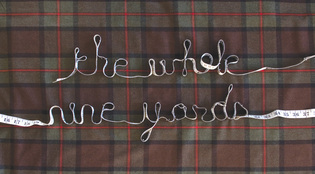 loading
loading
Arts & CultureYou can quote themYale law librarian Fred R. Shapiro is editor of the <i>Yale Book of Quotations</i>.
 Photo illustration: John Paul ChirdonView full imageEtymology is the -ology that gets no respect, a historical science that few people realize is a science. Although linguists use sophisticated comparative methods to analyze ancient roots of words, and more modern derivations can often be proven or disproven by research documenting precise early usages, such methods and findings are typically disregarded by word lovers who delight in colorful stories, even those that fly in the face of evidence -- or plausibility. It is a phrase rather than a word that is the most prominent etymological riddle of our time. That phrase, the whole nine yards, is both a magnet for fervid speculation and a goal that can be targeted with powerful modern research techniques. Databases including Google Books, ProQuest Historical Newspapers, and Newspaperarchive have digitized billions of pages of old books, newspapers, journals, and legal documents and made them searchable. With vast segments of the English-language book and periodical literature of past centuries now searchable, the Oxford English Dictionary and a talented group of amateur etymologists are able to dig deep into the history of the language and produce authoritative evidence previously unimaginable. The whole nine yards is a commonly used expression denoting "everything possible," as in this example from the American Heritage Dictionary of Idioms: "He decided to take everything to college -- his books, his stereo, his computer, his skis, the whole nine yards." Popular theories as to what "nine yards" originally referred to are legion. Ben Zimmer ’92, in an excellent article on the Visual Thesaurus website, enumerates the following conjectures:
The first three of these in particular have many passionate adherents, although all are lacking in documentation and have holes in their explanations; ammunition, for example, is measured by rounds rather than length. Scientific study of TWNY began with the Oxford English Dictionary, which traced its usage back to 1970. J. E. Lighter's Historical Dictionary of American Slang pushed the earliest dating back to 1967, citing The Doom Pussy, a book by Elaine Shepard about Vietnam War Air Force pilots. At that point all the earliest known citations were Air Force-related, pointing strongly to a military provenance. The OED and Lighter had used traditional historical-lexicographical procedures (random reading of books and other sources) to find their evidence, but then the database jockeys got into the act. A cadre of "antedaters" revealed a succession of older citations, reporting their discoveries on the Internet discussion list of the American Dialect Society. First, Sam Clements used Newspaperarchive to unearth a story about NASA slang in the San Antonio Express and News, April 18, 1964, including this tidbit: "'Give 'em the whole nine yards' means an item-by-item report on any project." Given the close nexus between the Air Force and NASA, the sentence seemed to strengthen the Air Force theory. Online lexicography marched on, however. Bonnie Taylor-Blake posted to the ADS list a Google Books-derived 1962 usage of nine yards that clearly seems to be the same idiom as whole nine yards:
Finally, Stephen Goranson, also searching Google Books, came up with a slightly earlier passage in a short story by Robert E. Wegner:
All this state-of-the-art research has not so far gotten us to the etymological El Dorado of a definitive explanation. The two earliest examples are somewhat contradictory in their import: the Car Life one assumes that the reader readily understands the nine yards metaphor, while the Michigan's Voices one introduces it as a cryptic catchphrase of a brush salesman. They do both seem to treat nine yards as the length of an extensive list (as does the third-oldest occurrence). Perhaps their main contribution is as negative evidence. Their context does not relate to the military, nor to the realms of cloth, concrete, or football. They are sufficiently removed from World War II to raise serious doubts about how a term from that war could have attained currency in the 1960s yet left no trace of prior usage. We don't yet have answers, but the questions are moving in new directions as the fog of speculation gives way to the light of fact.
The comment period has expired.
|
|